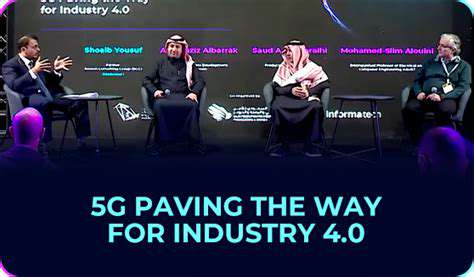Securing the Core: Network Segmentation
Implementing robust network segmentation is paramount in a 5G private network environment. This involves dividing the network into isolated segments, limiting the potential impact of a security breach within one segment to other parts of the network. By controlling traffic flow and access, organizations can significantly reduce the attack surface and contain the spread of malicious activity. This strategy is crucial for protecting sensitive data and critical applications, especially in industries where data breaches have severe financial and reputational consequences.
Careful consideration of network topology is vital. Strategically placing firewalls and intrusion detection systems within the segments allows for granular control and rapid response to security incidents. This approach enables targeted remediation without impacting the overall network operations, ensuring business continuity and minimizing downtime.
Advanced Authentication and Authorization
Moving beyond basic username/password authentication, 5G private networks can leverage more sophisticated authentication methods like multi-factor authentication (MFA) and biometric identification. These enhanced security protocols significantly reduce the risk of unauthorized access by demanding multiple forms of verification to confirm user identity. This added layer of protection is especially critical for accessing sensitive data and performing critical functions within the network.
Implementing role-based access control (RBAC) further strengthens security. By defining specific permissions for each user role, RBAC restricts access to resources based on job responsibilities. This granular control minimizes the potential for insider threats and ensures that only authorized personnel can access specific data or functionalities within the network.
Data Encryption and Protection
Data encryption is essential for safeguarding sensitive information transmitted over the network. Employing strong encryption algorithms, such as AES-256, ensures that data remains unreadable to unauthorized parties, even if intercepted. This is crucial for protecting customer data, intellectual property, and financial records.
Implementing data loss prevention (DLP) policies is another crucial step. These policies identify and prevent sensitive data from leaving the network perimeter, whether through accidental transmission or malicious intent. DLP solutions can monitor network traffic, identify potential data breaches, and alert administrators to suspicious activity, enabling timely intervention and minimizing the impact of data loss.
Zero Trust Architecture Implementation
Adopting a zero-trust architecture is critical for building a robust security posture in a 5G private network. This approach assumes no implicit trust in users or devices and verifies every access request, regardless of location or identity. This meticulous verification process significantly reduces the risk of insider threats and external attacks.
By constantly validating user and device identities, and enforcing strict access controls, a zero-trust architecture minimizes the potential damage from a successful compromise. This proactive security strategy is crucial for protecting against increasingly sophisticated cyber threats in today's digital landscape.
Threat Intelligence and Proactive Monitoring
Leveraging threat intelligence feeds allows organizations to stay ahead of emerging cyber threats. By analyzing real-time threat data, security teams can identify potential vulnerabilities and proactively implement mitigation strategies. This approach ensures that the network is continually protected against the latest attack vectors.
Implementing robust security information and event management (SIEM) systems allows for continuous monitoring of network activity. These systems collect and analyze security logs, identify anomalies, and generate alerts for potential threats. This proactive monitoring ensures that security teams are aware of any suspicious activity and can respond effectively to potential security incidents.

The Future of Enterprise Connectivity: A 5G-Powered Revolution

The Rise of AI-Powered Collaboration
Artificial intelligence is rapidly transforming the landscape of enterprise connectivity, offering unprecedented opportunities for streamlined communication and collaboration. AI-driven tools can analyze vast amounts of data to identify patterns and optimize workflows, leading to a more efficient and productive work environment. From intelligent chatbots that automate routine tasks to predictive analytics that anticipate potential issues, AI is poised to revolutionize how businesses connect and interact.
These advancements are not just about increased efficiency; they are also about creating a more inclusive and accessible work environment. AI-powered translation tools, for example, can bridge language barriers, enabling seamless communication across diverse teams and cultures. This has the potential to unlock new markets and foster a more globalized business landscape.
Enhanced Security Protocols for a Connected World
With the increasing reliance on digital platforms, enterprise connectivity demands robust security measures to protect sensitive data and maintain the integrity of communication channels. Modern security protocols must adapt to evolving threats, incorporating advanced encryption techniques and multi-factor authentication to safeguard against cyberattacks and unauthorized access. This requires a proactive approach to security, encompassing regular security audits and ongoing training for employees.
Protecting sensitive data is paramount in today's interconnected world. Organizations must prioritize data encryption and access controls to mitigate the risk of data breaches and ensure compliance with relevant regulations. This includes not only protecting company data but also ensuring the confidentiality of customer information.
The Impact of the Internet of Things (IoT)
The Internet of Things (IoT) is rapidly changing how businesses connect and interact with their environment. Integrating IoT devices into enterprise networks allows for real-time data collection, analysis, and automation, opening up new possibilities for process optimization and efficiency gains. The ability to gather and interpret data from connected devices enables businesses to make smarter decisions and respond more effectively to changing market conditions.
IoT integration has the potential to revolutionize entire industries, from manufacturing and logistics to healthcare and retail. By connecting physical assets with digital systems, companies can gain unprecedented insights into their operations, leading to significant improvements in efficiency and productivity.
Cloud-Based Connectivity Solutions
Cloud-based connectivity solutions are becoming increasingly important for modern enterprises, offering scalability, flexibility, and cost-effectiveness in managing communication and data exchange. Cloud platforms allow for seamless integration with various applications and services, enabling organizations to create more dynamic and responsive work environments. Leveraging cloud technology allows businesses to operate more agilely and respond rapidly to changing market demands.
Cloud solutions are also essential for remote workforces, enabling employees to access crucial information and collaborate effectively from anywhere with an internet connection. This flexibility is not only beneficial for employees but also helps companies reduce infrastructure costs and improve overall operational efficiency.
The Importance of User Experience (UX) in Connectivity
A crucial aspect of successful enterprise connectivity is the user experience (UX). Intuitive and user-friendly interfaces are essential to ensure that employees can easily navigate and utilize the available tools and resources. A positive UX fosters a productive and engaging work environment where employees feel empowered to collaborate effectively. This is important for both internal and external communication.
Prioritizing a positive UX ensures that employees feel comfortable and confident using the tools and platforms for communication and collaboration. This leads to improved efficiency and reduced frustration, creating a more positive and productive work environment. This also translates to improved customer satisfaction when external communication is streamlined and accessible.











